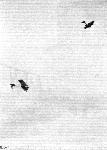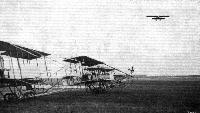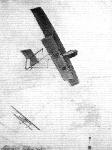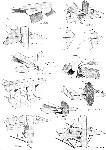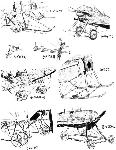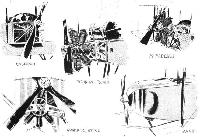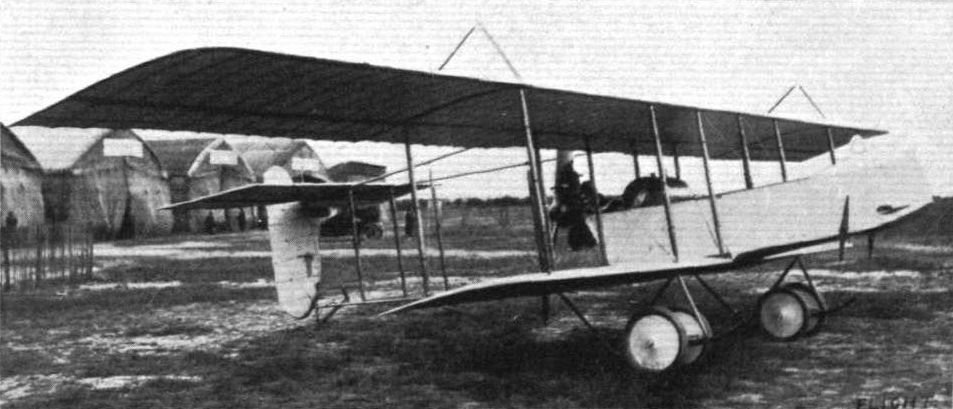
Описание
Страна: Франция
Год: 1912
.Two-seat reconnaissance, bombing and training aircraft
Варианты
- Farman - HF.6 - 1911 - Франция
- Farman - HF.14 / HF.23 - 1912 - Франция
- Farman - HF.15/16/20 - 1912 - Франция
- Farman - HF.16 - 1912 - Франция
- Farman - HF.19 - 1913 - Франция
- Schwade - Farman-Copy Biplane - 1913 - Германия
- Farman - HF.22 - 1914 - Франция
- В.Кондратьев Самолеты первой мировой войны
- А.Шепс Самолеты Первой мировой войны. Страны Антанты
- В.Шавров История конструкций самолетов в СССР до 1938 г.
- J.Davilla, A.Soltan French Aircraft of the First World War (Flying Machines)
- A.Durkota, T.Darcey, V.Kulikov The Imperial Russian Air Service (Flying Machines)
- L.Opdyke French Aeroplanes Before the Great War (Schiffer)
- M.Goodall, A.Tagg British Aircraft before the Great War (Schiffer)
- O.Thetford British Naval Aircraft since 1912 (Putnam)
- Jane's All The World Aircraft 1913
- E.Hauke, W.Schroeder, B.Totschinger Die Flugzeuge der k.u.k. Luftfahrtruppe und Seeflieger 1914-1918
- J.Davilla Italian Aviation in the First World War. Vol.2: Aircraft A-H (A Centennial Perspective on Great War Airplanes 74)
- W.Pieters The Belgian Air Service in the First World War (Aeronaut)
- Журнал Flight
-
J.Davilla, A.Soltan - French Aircraft of the First World War /Flying Machines/
Henri Farman H.F.20 of MF 44.
-
D.Mechin - Foreign Fronts of the French Air Force 1914-1919 /Aeronaut/
Henri Farman HF 20 n°68 used by Lt Cheutin, Biskra, 1913.
-
D.Mechin - Foreign Fronts of the French Air Force 1914-1919 /Aeronaut/
Henri Farman HF 20 (unknown no.) flown by Unteroffitser (adjutant) Alphonse Poire, assigned to the squadron reserved for the command of the 2nd Russian Army (2nd AAO) in January 1915.
-
A.Durkota, T.Darcey, V.Kulikov - The Imperial Russian Air Service /Flying Machines/
Henri Farman HF.20, winter 1915.
-
В.Кондратьев - Самолеты первой мировой войны
Henri Farman HF.20, 21-й корпусной авиаотряд ВВС России, конец 1914г.
-
А.Шепс - Самолеты Первой мировой войны. Страны Антанты
Разведчик/легкий бомбардировщик F.16, построенный по лицензии немецкой фирмой LVG (1913г.)
-
А.Шепс - Самолеты Первой мировой войны. Страны Антанты
Разведчик/легкий бомбардировщик Фарман F.20 ВВС Франции (1914г.)
-
W.Pieters - The Belgian Air Service in the First World War /Aeronaut/
JERO-HF20 ‘32’, crew and unit unknown
-
Журнал - Flight за 1912 г.
Several modifications were apparent in the Henry Farman biplanes seen at the Anjou meeting some time ago. The rear plane was quite flat and on a level with the top main plane. The lifting area amounted to 40 sq. metres.
-
Журнал - Flight за 1912 г.
The 80-h.p. Henry Farman biplane, showing in detail the tail formation and engine mounting.
-
M.Goodall, A.Tagg - British Aircraft before the Great War /Schiffer/
Airco Henry Farman F20. Served on operations into the early war years but by 1915 was used as a trainer. Also flown as a seaplane.
-
O.Thetford - British Naval Aircraft since 1912 /Putnam/
Henry Farman F.22. (F.20?)
-
Jane's All The World Aircraft 1913 /Jane's/
H. Farman. 1912-1913 military biplane.
-
P.Lewis - British Racing and Record-breaking Aircraft /Putnam/
Ready to release Louis Noel in a Maurice (???) Farman in one of the events at Hendon during 1914.
-
Журнал - Flight за 1912 г.
Mr. L. Noel on tbe Henry Farman at the Hendon Aerodrome.
-
H.Nowarra, G.Duval - Russian Civil and Military Aircraft 1884-1969
Farman F.16 in flight.
-
Журнал - Flight за 1913 г.
One of Chevillard's marvellous banks, with passenger, on the Farman biplane at Hendon Aerodrome.
-
Журнал - Flight за 1913 г.
The week before last we gave a photograph showing the remarkable banking of Chevillard on the Farman machine, as seen when approaching the spectator. Above, another bank is seen during one of his dives, and in this the view shows the tops of the planes and the inside of the nacelle, with pilot and passenger.
-
Журнал - Flight за 1913 г.
Chevillard, on his Farman, in the air at the Mirafiore Racecourse, Turin, commencing one of his steep banks, being watched by the spectators below.
-
Журнал - Flight за 1913 г.
CHEVILLARD IN ITALY. - At Pordenone Chevillard repeated his wonderful banking exhibitions on the Henry Farman, and the above sample of his work there, with Mr. Santoni as a passenger, has been sent us from Italy.
-
Журнал - Flight за 1914 г.
A B.E. and a Henry Farman flying at Upavon.
Другие самолёты на фотографии: RAF B.E.2/B.E.2a/B.E.2b - Великобритания - 1912
-
Журнал - Flight за 1913 г.
Not a swallow chasing a fly, but the Handley Page and a Henry Farman over the sheds at Hendon.
Другие самолёты на фотографии: Handley Page Type F / H.P.6 - Великобритания - 1912
-
Журнал - Flight за 1913 г.
A group of Italian officers at Pordenone, with M. Chevlllard and Mr. Lawrence Santoni, Managing Director of the "Savoia" Co. who are the Farman licensees in Italy, alter the reception of the Farman machines for the Government.
-
Журнал - Flight за 1913 г.
AIRCRAFT ON LAFFAN'S PLAIN FOR THE "FLY PAST" ON THE KING'S BIRTHDAY THIS WEEK. - In the parade there were four BE type, six Maurice Farmans, and two Henry Farmans.
Другие самолёты на фотографии: Maurice Farman MF.7 Longhorn - Франция - 1912RAF B.E.1 - Великобритания - 1911RAF B.E.2/B.E.2a/B.E.2b - Великобритания - 1912RAF B.E.3 / B.E.4 / B.E.7 - Великобритания - 1912
-
Журнал - Flight за 1914 г.
CENTRAL FLYING SCHOOL, UPAVON. - A Henry Farman in flight and some of the Maurice Farmans of B Flight on the ground.
Другие самолёты на фотографии: Maurice Farman MF.7 Longhorn - Франция - 1912
-
Журнал - Flight за 1914 г.
CENTRAL FLYING SCHOOL, UPAVON. - The Henry and Maurice Farmans of D Flight.
Другие самолёты на фотографии: Maurice Farman MF.7 Longhorn - Франция - 1912
-
J.Davilla, A.Soltan - French Aircraft of the First World War /Flying Machines/
H.F.20s based at Avord. Six escadrilles were equipped with H.F.20s (and its derivatives) in 1914.
-
Журнал - Flight за 1914 г.
Mr. Thornely on his biplane at the Munster Aerodrome, where he has been giving looping exhibitions last week, during the time that the Prince Henry flight was in progress. Tweer was also looping on a Blerlot.
-
Журнал - Flight за 1914 г.
Pilot : Mr. P. Verrier.
-
D.Mechin - Foreign Fronts of the French Air Force 1914-1919 /Aeronaut/
Henri Farmans HF 20 from Biskra, during their propaganda raid across North Africa, seen here in Tozeur (Tunisia) on February 27, 1913. (Collection Pierre Jarrige)
-
D.Mechin - Foreign Fronts of the French Air Force 1914-1919 /Aeronaut/
A Henri Farman HF 20 taking off from Biskra in 1913. (Collection Pierre Jarrige)
-
D.Mechin - Foreign Fronts of the French Air Force 1914-1919 /Aeronaut/
The Henri Farmans from Biskra are now in Colomb Bechar (Algeria, near Moroccan border). (Collection Pierre Jarrige).
-
В.Кондратьев - Самолеты первой мировой войны
"Фарман" F.15 постройки завода "Дукс"
-
J.Davilla, A.Soltan - French Aircraft of the First World War /Flying Machines/
H.F.16 serving with the Imperial Russian Air Service.
-
A.Durkota, T.Darcey, V.Kulikov - The Imperial Russian Air Service /Flying Machines/
Henri Farman HF.20 with an unknown corps unit. Suk flew this type with the 26 Corps Detachment between January and July, 1916.
-
A.Durkota, T.Darcey, V.Kulikov - The Imperial Russian Air Service /Flying Machines/
Members of the 21st Corps Detachment preparing for a mission in late 1914. The Lebed 7 carries the markings of the squadron on the tail, aircraft 1, and on the fuselage with Roman numerals XXI. The Lebed work number is above that, just aft of the cockpit. The squadron's Farman is also ready for flight.
Другие самолёты на фотографии: Лебедев Лебедь-VII / Лебедь-VIII - Россия - 1915
-
A.Durkota, T.Darcey, V.Kulikov - The Imperial Russian Air Service /Flying Machines/
The 21 st Corps Air Detachment based near Lida, circa fall 1914. The unit's mix of aircraft included at least two types - Henri Farman 20s and Lebed VIIs.
Другие самолёты на фотографии: Лебедев Лебедь-VII / Лебедь-VIII - Россия - 1915
-
A.Durkota, T.Darcey, V.Kulikov - The Imperial Russian Air Service /Flying Machines/
Henri Farman 20 from the 21 st Corps Detachment, circa fall 1914.
-
J.Davilla, A.Soltan - French Aircraft of the First World War /Flying Machines/
H.F.20 in Russian service. Approximately 200 H.F.20s were built under license by the Shchetinin and Anatra plants from 1912 until 1922.
The Farman XX was virtually the type XVI with minor refinements. It initially performed reconnaissance duties and later was employed as a trainer. About 200 were built in Russia, many by Dux. -
H.Cowin - Aviation Pioneers /Osprey/
The two seat Farman HF 22 derived from the pre-war Farman F 16 and when fielded in 1914 as a reconnaissance bomber proved somewhat underpowered under the urging of its 80hp Gnome. Hampered by its limited top speed of 65mph at sea level, the HF 22 took a severe mauling from the enemy and by mid-1915 had been withdrawn from front-line duties to the training role. The type served with the French, both British service arms and Belgium.
-
J.Davilla - Italian Aviation in the First World War. Vol.2: Aircraft A-H /Centennial Perspective/ (74)
Farman H.F.20 in French service. Six escadrilles were equipped with the H.F.20 and its derivatives in 1914.
-
J.Davilla, A.Soltan - French Aircraft of the First World War /Flying Machines/
H.F.20 assigned to the C.R.P. in September/October 1914 preparing to leave on a reconnaissance mission.
-
J.Davilla, A.Soltan - French Aircraft of the First World War /Flying Machines/
H.F.20 of the Swiss Fliegertruppe. Switzerland had two H.F.20s which were used from 1914 until 1920. Renaud.
-
J.Davilla, A.Soltan - French Aircraft of the First World War /Flying Machines/
Swiss Fliegertruppe in 1914; the center aircraft is an H.F.21. Reairche.
-
K.Delve - World War One in the Air /Crowood/
Voisin (???) biplane - used as a reconnaissance aeroplane and night bombing.
-
J.Forsgren - Swedish Military Aircraft 1911-1926 /Centennial Perspective/ (68)
The crew of a Farman HF 22 being greeted following landing. Via Arlanda Flygsamlingar
-
J.Forsgren - Swedish Military Aircraft 1911-1926 /Centennial Perspective/ (68)
Carl Silow prepares to fly a Farman HF 22. With the engine running, a number of mechanics are holding the airplane back prior to take-off. Via Arlanda Flygsamlingar
-
H.Nowarra, G.Duval - Russian Civil and Military Aircraft 1884-1969
Farman F.16 with ski undercarriage.
-
H.Nowarra, G.Duval - Russian Civil and Military Aircraft 1884-1969
Skis and skids. A Farman 16 equipped with winter-type undercarriage, interchangeable with wheels for operation in more temperate conditions.
-
В.Шавров - История конструкций самолетов в СССР до 1938 г.
"Фарман-15" с пулеметной установкой поручика В. Р. Поплавко
-
K.Delve - World War One in the Air /Crowood/
While the BE2 was the main tractor type in British service, the Farmans were the prime pusher types, as shown here in this line up of Henri-Farmans including '274, '351, and 708 (with BE2s in the background). The advantage with this design was that the observer in the nose had an exceptional all-round view.
-
H.King - Sopwith Aircraft 1912-1920 /Putnam/
Commander Samson's Eastchurch Squadron of the RNAS at Dunkirk in 1914. The aeroplanes are (left to right): Henry Farman F.20. Samson's B.E.2a (No.50). Sopwith Tractor Biplane and Short No.42.
Betrayed - or proclaimed by its windows, though distant in this Farman/B.E./ Short Astra-Torres gathering, is a Sopwith tractor biplane of the 'Three-seater' family.Другие самолёты на фотографии: RAF B.E.2/B.E.2a/B.E.2b - Великобритания - 1912Short S.60 / RNAS 42 - Великобритания - 1913Sopwith Three-Seater - Великобритания - 1913
-
K.Delve - World War One in the Air /Crowood/
Workshops at the Central Flying School, one ot the elements established when the British created their military air arms in 1912. The rudder to the right shows aircraft 412, a Henri-Farman (formerly serial No 208), one of two Henri-Farmans acquired by the Royal Flying Corps when it formed in 1912. Like so many of the early aeroplanes used by European nations these were of French manufacture.
-
E.Hauke, W.Schroeder, B.Totschinger - Die Flugzeuge der k.u.k. Luftfahrtruppe und Seeflieger 1914-1918
Farman HF 21, russisches Beuteflugzeug, bei der Flik 10 in der Nähe von Pilatkovce (Galizien) gelandet und erbeutet. Die Aufnahme zeigt das Flugzeug bei der Kriegsausstellung in Wiener Neustadt im April 1916. Im Hintergrund weitere russische Beuteflugzeuge (Moräne- und Nieuport-Findecker). Flugzeugnummer 00.07
Farman HF 21 российский трофейный самолет, приземлился и захвачен Flik 10 недалеко от Пилатковце (Галиция). На фотографии показан самолет на военной выставке в Винер-Нойштадте в апреле 1916 года. На заднем плане - другой российский трофейный самолет (моноплан Morane или Nieuport). Номер самолета 00.07 -
М.Маслов - Русские самолеты Первой Мировой /Эксмо/
Оригинальная подпись гласит, что на фото сборочная аппаратов (манеж), относящаяся к 6-й авиароте. Представленные аппараты Румплер, Шнейдер, Фарман свидетельствуют о наличии в эксплуатации значительного количества самолетов иностранного производства
Другие самолёты на фотографии: LVG B.I - Германия - 1914Rumpler B.I/4A - Германия - 1914
-
W.Pieters - The Belgian Air Service in the First World War /Aeronaut/
Lieutenant Felix Liedel who was mortally wounded in a crash at Martelange on 28 June 1914. He died on the way to hospital.
-
W.Pieters - The Belgian Air Service in the First World War /Aeronaut/
JERO Farman F16, manned by Robert Dhanis (L) and Emmanuel Bronne.
-
W.Pieters - The Belgian Air Service in the First World War /Aeronaut/
Lieutenant Baron Theo Wahis was destined to become the third Commanding Officer of the Av.M. early 1915.
-
W.Pieters - The Belgian Air Service in the First World War /Aeronaut/
Baron Theo Wahis (L) and Lucien Poot in a JERO-Farman HF20.
-
W.Pieters - The Belgian Air Service in the First World War /Aeronaut/
Sergent Max Orban (L) and Sous-Lieutenant Lucien Orban flew one mission together on October 17th, 1915. They were, however, not related to one another.
-
W.Pieters - The Belgian Air Service in the First World War /Aeronaut/
Pierre de Chestret & Joseph Gilles, 5me Esc, both relative new at the front, were forced to land on 3 April 1916.
-
W.Pieters - The Belgian Air Service in the First World War /Aeronaut/
Sgt Georges Labrique, a novice pilot with 6me Esc, who arrived at the front in June 1918, destroyed a Nieuport scout in a forced landing, being slightly injured, on 17 July 1918.
-
W.Pieters - The Belgian Air Service in the First World War /Aeronaut/
Lieutenants Pierre Lebon (L) and Julien Stellingwerff on the day of their trial with a mounted machine gun. This was the first such test in Europe.
-
W.Pieters - The Belgian Air Service in the First World War /Aeronaut/
The JERO-Farman HF20 which was used for the first trials with a mounted machine gun at Brasschaet during May 1911.
-
J.Davilla, A.Soltan - French Aircraft of the First World War /Flying Machines/
H.F.20 in Belgian service. The Jero firm produced 24 H.F.20s beginning in 1912. R. Verhegghen via Colin Owers.
-
W.Pieters - The Belgian Air Service in the First World War /Aeronaut/
The JERO-Farman HF20 was the standard aircraft in the beginning of the war.
-
W.Pieters - The Belgian Air Service in the First World War /Aeronaut/
Farman HF20 over the front.
-
W.Pieters - The Belgian Air Service in the First World War /Aeronaut/
Picture probably taken during the army exercises in August 1913. From Left to right are: unknown, Adhemar Tapproge, Jean Hagemans, Paul Richard, Eugene Moulin, Arsene Demanet, Jules Soumoy and Fernand Jacquet.
-
W.Pieters - The Belgian Air Service in the First World War /Aeronaut/
Lieutenant Georges Nells who was the first military brevetted pilot.
-
W.Pieters - The Belgian Air Service in the First World War /Aeronaut/
Lieutenant Felis Isserentant & Sous-Lieutenant Edouard Delfosse, IIme Escadrille, in their Farman F20.
-
W.Pieters - The Belgian Air Service in the First World War /Aeronaut/
Sous-Lieutenants F.de Woelmont & P.Braun teamed up early March 1915.
-
W.Pieters - The Belgian Air Service in the First World War /Aeronaut/
Caporals Jacques de Meeus d’Argenteuil, Charles Kervyn de Lettenhove & Edmond Desclee at the pilot school, prior of being sent to the front in July 1915.
-
W.Pieters - The Belgian Air Service in the First World War /Aeronaut/
Lieutenants Robert Dhanis & Emmanuel Bronne prepare for a flight.
-
W.Pieters - The Belgian Air Service in the First World War /Aeronaut/
Chef d’Escadrille of lime Escadrille HF, Lieutenant Jules Soumoy. Capitaine Jules Soumoy crashed a new Farman F20 on take-off at Buc, France on 5 September 1914. He did not survive this crash.
-
W.Pieters - The Belgian Air Service in the First World War /Aeronaut/
Aircrew at rest somewhere in a field: L to R: Unknown, Fernand Jacquet, Paul Hiernaux, and Felix Isserentant.
-
W.Pieters - The Belgian Air Service in the First World War /Aeronaut/
Another shot at the pilot school: L to R: F.Lescart, W.de Roy, French officer, G.Mestach, unknown, R.Lagrange, R.Castiau on the wing, and R.Vertongen in the cockpit.
-
Журнал - Flight за 1912 г.
Mr Louis Noel, who has made such splendid flights at Hendon, in the pilot's seat of the Henry Farman, ready to get away in the first heat for the Speed Handicap at Hendon last week.
-
Журнал - Flight за 1913 г.
M. Chevillard, who has been making such sensational flights on the Farman machines at Hendon.
-
Журнал - Flight за 1914 г.
Mr. J. E. B. Thornely, the very able seventeen-year-old pilot who last week looped the loop at Eastbourne.
-
Журнал - Flight за 1914 г.
MR. J. E. B. THORNELY, who, as recorded in FLIGHT for March 28th, recently looped the loop on a Farman biplane at Eastbourne. Mr. Thornely, who will not be 18 until July 5th next, joined the Eastbourne Aviation Co.'s School in October, 1912, and last year practised on a Bleriot monoplane and later on a Bristol biplane.
-
J.Davilla, A.Soltan - French Aircraft of the First World War /Flying Machines/
H.F. 21 with crew. Reairche.
-
D.Mechin - Foreign Fronts of the French Air Force 1914-1919 /Aeronaut/
Lieutenant Etienne Cheutin was one of the first military pilots of the French airforce. He conducted a raid from Biskra to Tunis with 3 other pilots on February 1913 at the commands of a Henri Farman HF 20. In 1917, with the rank of commandant (Major), he was named commanding officer of the aviation in Morocco. He ended his career in 1934 with the rank of General.
-
Журнал - Flight за 1913 г.
Capt. C. E. Risk, R.M.L.I., and Artificer Frank Susans, with the Farman biplane, landed in a ploughed field at Sanderstead last Friday. Capt. Risk afterwards rose easily. It being subsequent to this that, through engine trouble, the machine was wrecked at Queenborough.
-
W.Pieters - The Belgian Air Service in the First World War /Aeronaut/
Damaged wings of a Farman, which had been hit by AA-fire.
-
W.Pieters - The Belgian Air Service in the First World War /Aeronaut/
Capitaine Francois Dechamps was killed on 21 December 1914, whilst handing a bomb to one of his mechanics. The latter let it slip through his fingers and the explosion caused some 15 casualties, including Dechamps.
-
W.Pieters - The Belgian Air Service in the First World War /Aeronaut/
Lieutenants E.Moulin & P.Rigaux crashed this JERO-Farman HF20 sometime in March 1915.
-
Журнал - Flight за 1915 г.
WOUNDED FLYER. - A Henry Farman biplane brought down by shell fire.
-
W.Pieters - The Belgian Air Service in the First World War /Aeronaut/
Fatal crash in which Lieutenant Hubert lost his life on 10 July 1914 at Kiewit.
-
W.Pieters - The Belgian Air Service in the First World War /Aeronaut/
Jean Godefroid crashed and was seriously injured. He could not continue to be trained as a pilot.
-
W.Pieters - The Belgian Air Service in the First World War /Aeronaut/
What is left of Godefroid’s JERO Farman HF20.
-
W.Pieters - The Belgian Air Service in the First World War /Aeronaut/
JERO Farman HF20, # 22 after its crash in Roosteren, Holland. Its crew, Lieutenants Albert de Bueger and Albert Schmit, were released but the Farman was left in Dutch hands.
-
W.Pieters - The Belgian Air Service in the First World War /Aeronaut/
Lieutenants Jules Jaumotte and Leopold Bussy, IIme Escadrille HF crashed on 24 October 1914 at Furnes.
-
W.Pieters - The Belgian Air Service in the First World War /Aeronaut/
The remains of the Farman flown by Adjt Charles Ciselet. Observer Lt Joseph Gilles did not survive.
-
Журнал - Flight за 1914 г.
Mr. J. Grant's Farman type biplane, constructed from scale drawings which have appeared in FLIGHT.
-
Журнал - Flight за 1912 г.
A post impression of Thursday week's Illuminated Flying Meeting at the London Aetodrome, Hendon. - Capt. Tyrer, as a passenger on a Henry Farman biplane, throws bombs on a dummy battleship. Another biplane, its leading edge starred with lights, forms a new "constellation" at the left top corner.
-
Журнал - Flight за 1913 г.
LORD MAYOR'S DAY AT HENDON AERODROME. - A race impression of Chevillard and Verrier by Roderick Hill.
Другие самолёты на фотографии: Maurice Farman MF.7 Longhorn - Франция - 1912
-
W.Pieters - The Belgian Air Service in the First World War /Aeronaut/
Romantic view of the first (unofficial) Belgian aerial combat victory.
Другие самолёты на фотографии: Etrich Taube - Австро-Венгрия - 1910
-
Журнал - Flight за 1913 г.
Chassis details of the Henry Farman biplane. Notice the ball joint for the radius-rods and the simple manner in which the rubber cored shock-absorbers are fitted.
-
Журнал - Flight за 1913 г.
Plane strut fitting, showing the warping wire pulleys on the H. Farman biplane.
-
Журнал - Flight за 1913 г.
How oblique stay wires are carried past struts on the H. Farman biplane.
-
Журнал - Flight за 1913 г.
How the tail control wires are guided at the side of a strut on the Henry Farman biplane.
-
Журнал - Flight за 1913 г.
The Henry Farman tail-skid.
-
Журнал - Flight за 1912 г.
The 80-h.p. Henry Farman biplane and its electric light and Klaxon horn fittings. - Fig. 1. - Side view. Fig. 2. - Empennage, showing the new rudder shape. Fig. 3. - Petrol and castor oil tanks. Fig. 4. - Control cable joint. Fig. 5. - Electric searchlight. Fig. 6. - Electric side lights. Fig. 7. - Klaxon electric horn.
-
Журнал - Flight за 1913 г.
The 80-h.p. Henry Farman biplane.
-
Журнал - Flight за 1913 г.
Другие самолёты на фотографии: Bleriot Bleriot-XI-2 - Франция - 1911Breguet 3 - Франция - 1910Bristol BR.7 - Великобритания - 1913Bristol Coanda monoplane - Великобритания - 1912Caudron C / D / E - Франция - 1912Caudron N - Франция - 1911Cody No.5 - Великобритания - 1912Deperdussin hydro-monoplane - Франция - 1912Deperdussin Racer - Франция - 1912Maurice Farman MF.7 Longhorn - Франция - 1912RAF B.E.2/B.E.2a/B.E.2b - Великобритания - 1912
-
Журнал - Flight за 1913 г.
AT OLYMPIA. - A study in tail-skids.
Другие самолёты на фотографии: Avro Type E / 500 - Великобритания - 1912Bleriot Bleriot-XI-2 - Франция - 1911Caudron N - Франция - 1911Cody No.5 - Великобритания - 1912Deperdussin Racer - Франция - 1912Grahame-White Type VI military - Великобритания - 1913Handley Page Type E / H.P.5 - Великобритания - 1912Martin & Handasyde Model of 1912 year - Великобритания - 1912Maurice Farman MF.7 Longhorn - Франция - 1912RAF B.E.2/B.E.2a/B.E.2b - Великобритания - 1912Sopwith Three-Seater - Великобритания - 1913Vickers EFB.1 - Великобритания - 1913Vickers No.6 / No.8 - Великобритания - 1912
-
Журнал - Flight за 1913 г.
A study in tails.
Другие самолёты на фотографии: Avro Type E / 500 - Великобритания - 1912Caudron N - Франция - 1911Cody No.5 - Великобритания - 1912Grahame-White Type VI military - Великобритания - 1913Grahame-White Type VIII hydro - Великобритания - 1913Martin & Handasyde Model of 1912 year - Великобритания - 1912Maurice Farman MF.7 Longhorn - Франция - 1912Short S.41 seaplane - Великобритания - 1912Vickers No.6 / No.8 - Великобритания - 1912Wight No.1 Seaplane - Великобритания - 1913
-
Журнал - Flight за 1915 г.
Various types of double skid undercarriages.
Другие самолёты на фотографии: Bristol Coanda monoplane - Великобритания - 1912Caudron G.3 - Франция - 1913Dyott monoplane - Великобритания - 1913Maurice Farman MF.11 Shorthorn - Франция - 1913Sopwith Tabloid - Великобритания - 1913
-
Журнал - Flight за 1916 г.
Some engine mountings ad housings on "pusher" biplanes.
Другие самолёты на фотографии: Avro 508 - Великобритания - 1914Caudron Type K - Франция - 1913Dunne D.8 - Великобритания - 1911Grahame-White Type XI Military - Великобритания - 1913
-
A.Durkota, T.Darcey, V.Kulikov - The Imperial Russian Air Service /Flying Machines/
Henri Farman HF.20, winter 1915.
-
В.Кондратьев - Самолеты первой мировой войны
Farman F.16
-
Журнал - Flight за 1912 г.
HENRY FARMAN BIPLANE. - Plan and elevation to scale.
-
A.Durkota, T.Darcey, V.Kulikov - The Imperial Russian Air Service /Flying Machines/
Henri Farman F.20 Floatplane
В.Кондратьев Самолеты первой мировой войны
ФАРМАН F.15/16/20 / FARMAN F.15/16/20
Двухместный полутораплан с толкающим винтом. Разработан известным французским авиаконструктором Анри Фарманом в 1912 году. Конструкция смешанная. Продольные балки хвостовой фермы, контуры оперения и элементы шасси из стальных труб, крылья деревянные с полотняной обшивкой, гондола выклеена из фанеры.
Уже в 1913-м "Фарман" F.15 принят на вооружение французских, английских, российских и бельгийских ВВС в качестве связной и разведывательной машины. Позднее самолет появился в Италии, Румынии и некоторых других странах. Созданные вскоре модификации F.16, F.20 и F.21 отличались площадью крыльев и рядом незначительных технологических усовершенствований. Все три типа выпускались серийно на заводе фирмы Фарман в Билланкурте, и на российских заводах Щетинина, Лебедева и "Дукс". Всего в России построено около 300 F.16 и до 200 F.20 и F.21. В 1914 году во Франции и в России запущен в серию "Фарман" F.22 с улучшенной конструкцией тележек шасси (без противокапотажных лыж) и более широким применением металла.
К началу первой мировой войны "Фарманы" различных модификаций были весьма популярны во всех странах Антанты. Объясняется это во-первых исключительной легкостью и простотой пилотирования, присущей всем изделиям Анри Фармана, а во-вторых - активной рекламой и авторитетом фирмы. На западном фронте машинами Анри Фармана были полностью оснащены 5 французских, 6 английских и 2 бельгийских эскадрильи. Но при этом слабая энерговооруженность F.20, F.21 и F.22 сильно ограничивала боевое применение этих машин. Установка пулемета и принятие на борт даже небольшой бомбовой нагрузки резко ухудшали и без того невысокие летные характеристики "Фарманов", оснащенных маломощными ротативными двигателями. В результате к лету 1915 на западе, а в начале 1916 и в России их перевели в разряд учебных. Однако в период гражданской войны хроническая нехватка самолетов как у красных, так и у белых заставила вновь использовать эти безнадежно устаревшие машины по их прямому назначению -в качестве разведчиков и самолетов связи. Последние F.22, служившие в Севастопольской летной школе, списали в 1923 году.
ДВИГАТЕЛЬ
На "Фарманы" устанавливали различные ротативные моторы: "Гном" (70, 80 или 100 л.с.), "Рон" (80 л.с.), "Клерже" (80 л.с.), иногда "Гном-Моносупап" в 100 л.с.
ВООРУЖЕНИЕ
Не предусмотрено. Иногда в частях ставили подвижный "Кольт", "Виккерс" или "Льюис" на шкворне у летнаба.
Описание:






















